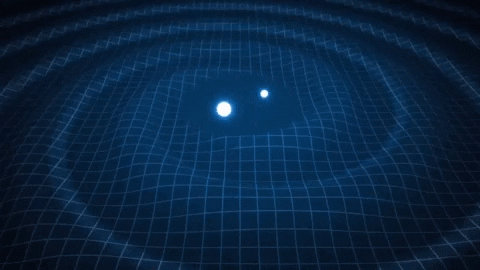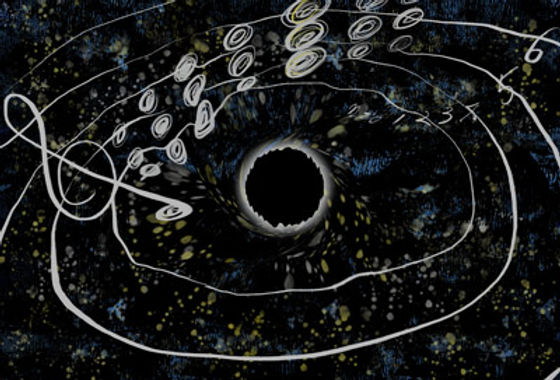
SOUND X MIND : WAVES OF SPACETIME
The Spatial Music Mind Textile® design concept of "Sonic Particles and Mind Ripple Interference” offers an immersive exploration into the convergence of sonic particles, mental states, and the theoretical framework of string M-theory. Drawing inspiration from gravitational waves, the concept seeks to elucidate the dynamic relationship between sound and mind waves, echoing interference ripples in spacetime.

SONIC PARTICLES AND MIND RIPPLE INTERFERENCE
IN STRING M-THEORY
Through interactive engagement with an 88-key grand piano frequency and music emotion recognition-generated patterns in smart textiles, participants gain insights into the interconnectedness of sound, consciousness, and the fabric of the universe. This multidisciplinary exploration breaks boundaries of human perception, providing an immersive experience that transcends the realms of theoretical physics, cognitive science, and sonic exploration.
GRAVITATIONAL WAVES
are ripples or vibrations in space-time (the fabled “fabric” of the Universe) caused by massive objects moving with extreme accelerations. In outer space that means objects like rapidly rotating lumpy neutron stars, or neutron stars or black holes orbiting around each other ever closer at ever increasing rates and eventually colliding, or stars that blow themselves up (a supernovae). These ripples travel through space at the speed of light in all directions from their source, dissipating in strength with distance, and passing through everything in their paths.


Spiral Dance of Black Holes This illustration shows the merger of two black holes and the gravitational waves that ripple outward as the black holes spiral toward each other. The black holes—which represent those detected by LIGO on Dec. 26, 2015—were 14 and 8 times the mass of the sun, until they merged, forming a single black hole 21 times the mass of the sun. In reality, the area near the black holes would appear highly warped, and the gravitational waves would be difficult to see directly. Image credit: LIGO/T. Pyle (*The LIGO Laboratory is supported by the National Science Foundation and operated jointly by Caltech and MIT.)
Understanding gravitational waves: Ripples in spacetime explained
The universe is ringing with gravity, but humanity is only just beginning to hear the nuance of this cosmic symphony.
How close are we to hearing the full gravitational wave symphony?
We stand on the cusp of hearing the full gravitational wave symphony, akin to an orchestra of cosmic proportions. Just as different instruments are needed to detect various wavelengths of light in astronomy, different detectors are required for gravitational waves. Ground-based detectors like LIGO, Virgo, and KAGRA use laser interferometers to sense minute spacetime distortions caused by colliding celestial bodies. However, they are limited by Earth-based interference. To overcome this, plans are underway for the Laser Interferometer Space Antenna (LISA), a space-based detector capable of capturing lower-frequency gravitational waves. Additionally, pulsar timing arrays like NANOGrav offer a unique perspective, using rapidly rotating pulsars as cosmic beacons to detect gravitational wave disturbances.
To think of how extraordinary humanity “hearing” any of this symphony is consider this: the stretching and squeezing of spacetime they represent is tiny, about one part in a quadrillion (1,000,000,000,000,000). Einstein himself, though arguably the “father” of gravitational waves, never believed that humanity would have the tools needed to detect even the most energetic spacetime ripples. Fortunately, the great physicist was wrong, and by combining the detection of gravitational waves, humanity can both “see” the Universe in electromagnetic radiation and can “hear” it via these ripples in spacetime. This has given rise to an entirely new phase in astronomy called multi-messenger astronomy, a hybrid method of investigation which, though still in its infancy, promises to unlock the secrets of the Universe as never before. (*by Robert Lea, Advanced Science News, Aug 15, 2023 )
References:
What are Gravitational Waves? LIGO Caltech, Accessed 01/08/23
Gravitational wave spectrum, Caltech, Accessed01/08/23
Low-Frequency Gravitational Waves, Nanograv, Accessed 01/08/23
The spectrum of gravitational waves, ESA, Accessed 01/08/23

When two black holes collide and merge, the new bigger black hole rings like a bell, generating gravitational waves that eventually dampen. © 2022 RIKEN Interdisciplinary Theoretical and Mathematical Sciences Program
